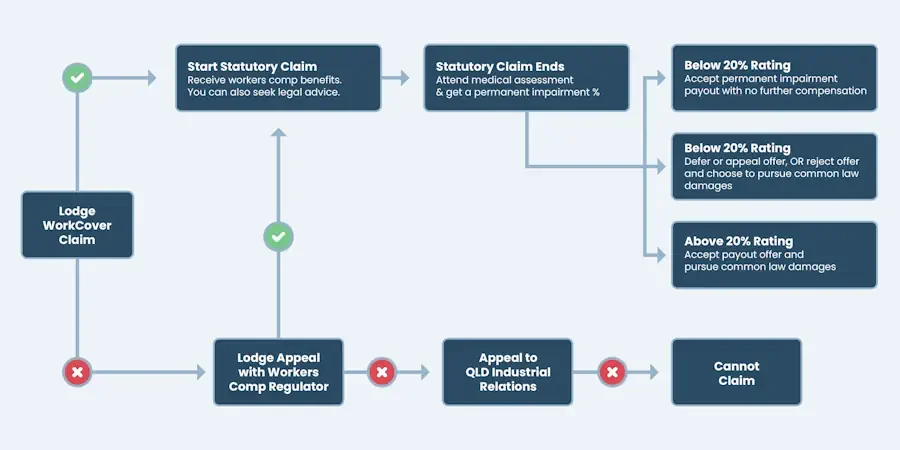When you suffer a work injury caused by employer negligence, you could be eligible for a WorkCover Queensland common law payout. Depending on the DPI rating, this further compensation could replace or be in addition to a permanent impairment payout.
The Workers Compensation Lawyers QLD offers a free case review that can explain the types of compensation and your eligibility to seek common law damages. We also provide a 100% no-win, no-fee, no-risk guarantee for all our legal services. Pay only for a win and nothing if you lose.
Check it out!
WorkCover common law claims are fault-based claims that require proof of negligence. Also known as common law damages, they involve legal action to seek compensation for work-related injuries caused by the negligence of an employer or a third party. In the context of WorkCover QLD, these claims hold employers accountable for failing to meet their duty of care. When an employer breaches this duty, an employee with work-related injuries could have the right to seek compensation for their losses.
Common law claims are similar to other types of claims for negligence. In both cases, you must prove that your employer or a third party failed to uphold their legal obligations, and this duty failure caused a physical or psychiatric injury.
An approved common law claim provides injured workers with a one-time lump sum payment as the final settlement of a workers’ compensation claim. When weekly payments end, these funds seek to compensate for the long-term impacts of their injuries, and particularly for those with a permanent loss.
A lump sum payment seeks to return your life to its pre-injury state, which can be challenging for those living with permanent injuries.
Common law claims provide a range of compensation aimed at covering both economic and non-economic losses. They address all types of financial and personal impacts resulting from workplace injuries.
If you have an accepted workers compensation claim with QLD WorkCover, you could be eligible to start a common law claim for damages.
The Workers Compensation Lawyers QLD provides a free case assessment that can explain the common law claim process and the eligibility requirements. Furthermore, all our workplace injury legal services come with a 100% no-win, no-fee, no-risk guarantee. It’s free to know your rights and entitlements. Call 1800 575 023
Demonstrating negligence forms the basis of the common law claim process. This process often requires gathering extensive evidence.
To successfully pursue a common law claim, you must prove there was an owed duty a care and a failure to take reasonable steps to ensure the safety of workers. Here is what you need to establish:
Workers injured in QLD who make a common law claim carry the burden of proof. Hence, they must have compelling evidence, such as:
You have the right to seek independent legal advice regarding your eligibility to claim damages under common law. The Workers’ Compensation Lawyers QLD can explain how it works during a free case review, and our 100% no-win, no-fee, no-risk policy. Call 1800 575 023
Workplace injury insurers often try to limit their liability to pay common law damages. One tactic they use is to argue that an employee contributed to the accident or illness and/or worsened their injury. The legal term for this principle is contributory negligence.
The level of contributory negligence has a direct impact on the amount of compensation paid to the claimant, as the law may reduce damages proportionally to reflect the worker’s share of responsibility. For example, if a worker fails to follow safety protocols or neglects to use protective equipment, the insurance company can argue that they contributed to their injury.
An experienced workers’ compensation solicitor understands how this process works and would seek to negotiate a lower level of contribution during settlement negotiations.
An experienced workers’ compensation solicitor understands how this process works and would seek to negotiate a lower level of contribution during settlement negotiations. However, a court may also decide the percentage.
Pre-existing injuries or conditions also impact the outcome of common law claims. If an injury is aggravated or worsened by a workplace incident but originates from an existing condition, the compensation may be adjusted to account only for the additional harm caused by the employer’s negligence.
In this case, separating the effects of pre-existing conditions from the new work-related injury depends heavily on medical evidence and expert testimony.
WorkCover QLD common law payouts can cover work-related illnesses, physical injuries, and psychiatric conditions. Any recognised and diagnosed mental health disorder caused directly by workplace incidents or ongoing work-related stress might qualify, including:
Queensland workers’ compensation scheme statistics for 2023-2024 reveal that psychiatric injury claims make up about 15.1% of common law lodgements in Queensland. Unlike physical injuries, psychiatric injuries can be harder to prove and quantify since they are not visible injuries and therefore need thorough medical and psychological assessments to establish a case.
The value of WorkCover QLD common law payouts is usually confidential because most claims settle through mediation, with both parties signing a non-disclosure agreement. However, some cases proceed to court litigation, with the results available at the Queensland judgments website.
Worksafe QLD statistics for 2023-2024 report that the average settlement amount for a successful common law claim in Queensland was $187,656. There is a significant range of payout values based on individual circumstances, including:

Calculating common law damages in WorkCover QLD claims involves a detailed assessment of both economic and non-economic losses suffered by the injured worker.
Economic losses are the measurable financial impacts caused by the injury, including:
Past and Future Loss of Income: Compensation for wages lost due to the inability to work after the injury, as well as anticipated future earnings lost or reduced by the injury.
Medical and Rehabilitation Expenses: Costs related to treatment, therapy, and ongoing care.
Out-of-Pocket Expenses: Travel costs for medical appointments, assistive devices, and other injury-related expenses.
Non-Economic Losses (Pain and Suffering Damages) compensate for intangible effects such as:
Physical pain and discomfort
Emotional distress and psychological trauma
Loss of enjoyment of life and diminished lifestyle
The worker’s degree of permanent impairment (DPI) is a factor for determining pain and suffering values. The DPI percentage reflects the severity and lasting impact of the injury, as assessed by medical professionals or the Medical Assessment Tribunal. A higher DPI typically corresponds to greater pain and suffering.
Contributory Negligence and Reductions: If the injured worker is found to have contributed to their injury through negligence (for example, by not following safety protocols), the damages awarded may be proportionally reduced to reflect this shared responsibility.

The process of making a common law claim under the Queensland workers’ compensation scheme begins when the employee completes a Notice of Claim for damages. This highly complex document details:
An employee will likely find it difficult to understand this document and how it relates to their entitlements under common law. Remember, you have the right to seek legal advice about your situation and the options that best suit your circumstances.
After reporting a work incident to their employer, an injured employee may lodge a statutory claim for workers’ compensation benefits with WorkCover QLD. This step indicates their intention to seek compensation for the harm they have experienced and the related financial loss.
A statutory claim under WorkCover Queensland is the first phase of seeking compensation for workplace injuries without the need to prove who was at fault. The end of statutory benefits often triggers the transition to common law proceedings, where the focus shifts from receiving weekly compensation and paying medical expenses to seeking further compensation for employer negligence.
Workers can seek independent legal advice before the statutory claim ends to evaluate their options and understand their common law rights.
The next step of the common law claim process is to attend a medical assessment by an independent medical examiner or the Medical Assessment Tribunal. They will examine an illness or injury and use established guidelines to determine its severity and long-term effects, including the degree of permanent impairment (DPI).
The worker’s degree of whole-person impairment directly affects the compensation amount, including lump-sum impairment benefits.
Based on the outcome of this assessment, WorkCover will send a lump sum offer to the claimant. The degree of impairment will determine their legal options.
Below 20% DPI, you have three options:
Above 20% DPI: Accept the lump sum offer and make a common law claim.
NOTE: The 20% impairment threshold cannot be reached by combining physical and psychological injuries to qualify as a more serious injury. This is because physical and psychological injuries are assessed separately. And some Australian states require a County Court application for a serious injury.
Claimants have the right to seek legal advice regarding their options, as their decision will significantly impact their legal outcome.
• You may need to make a serious injury application, depending on your state’s workers’ compensation scheme.
• Some states of Australia require an application through a County Court
Following the submission of the claim, a pre-proceeding phase begins, during which negotiations occur between the claimant’s legal representative and the employer or WorkCover.
During mediation, both parties strive to reach a fair resolution and avoid costly court battles.
If mediation fails to resolve a common law claim at a compulsory conference, the case may proceed to court litigation. A workers’ compensation lawyer would offer advice in this situation regarding the best course of action and possible results.
A court judgement offers an independent review of the negligence and damages claim, but its decisions are legally binding. Therefore, seeking legal advice before taking further legal steps is advisable.
The legislation governing WorkCover QLD common law payouts sets out maximum amounts for various types of damages, including general damages for pain and suffering and economic loss. These maximum amounts are periodically reviewed and indexed to reflect changes in economic conditions.
A free case review from our work injury legal team can explain how workers’ compensation law applies to your circumstances. Call 1800 575 023
Pain and suffering damages (also referred to as general damages) seek to compensate for the non-economic losses experienced by someone who has been injured at work. This component considers factors such as
Proof of pain and suffering includes evidence that shows the impact of injuries on the claimant’s daily life.
In Queensland, there is a statutory cap on the maximum damages for pain and suffering, currently set at $442,195 for the most severe injuries.
In certain circumstances, claimants have the option to request a court to extend the limitation period. However, the court generally requires a valid reason for the delay and does not guarantee these extensions.
The Workers Compensation Lawyers QLD can advise you on the time limits applicable to your situation during a free case review. Call 1800 575 023
The Worksafe website explains your right to legal representation for workers’ compensation common law claims and states the following:
The site also explains that to have a successful common law claim for damages, you must:
It is strongly recommended that you seek advice because the process of proving negligence and establishing the value of damages requires robust evidence and negotiation with the workers’ compensation insurance company (which is usually WorkCover, although some employers are self-insured).
The Workers Compensation Lawyers QLD offer a free case review that can explain your rights and entitlements when injured at work.
All our personal injury legal services come with a genuine no-win, no-fee, no-risk guarantee. Pay only after a win, and zero if you lose. It’s free to know where you stand. Call 1800 575 023
According to WorkSafe, the majority of WorkCover common law claims are settled within one year. However, they may take longer if a matter proceeds to court.
To start a common law claim, workers need to submit a notice of claim for damages that outlines the allegation of negligence against their employer and explains why they are liable for damages.
A common law claim under WorkCover QLD is a legal action you can take to seek damages if you’ve been injured due to employer or third-party negligence. An approved claim typically results in a lump sum payment to compensate for the effects of the injury and the related financial loss.
A claimant can seek compensation for non-economic losses (general damages) like pain and suffering, and economic losses such as:
Generally speaking, a serious injury is a condition that leads to a serious outcome, such as:
A very serious personal injury (also referred to as a critical injury) is one that leads to permanent impairment or long-term damage.
To prove employer negligence, you need to demonstrate that the other party breached their duty of care, supported by solid evidence like:
Queensland workers are entitled to a safe workplace, which means your employer has a duty to keep you safe. If they fail this duty, workers injured on the job (or during work-related activities) could commence legal proceedings seeking damages for past, current and future loss, depending on the circumstances.


